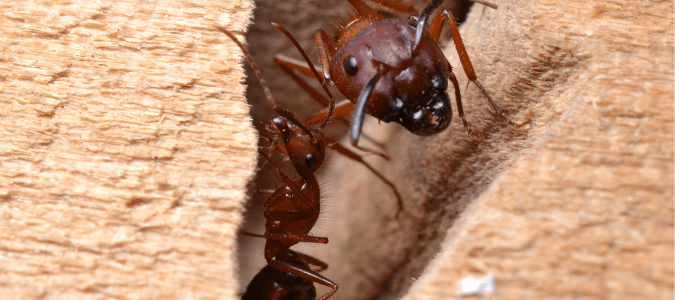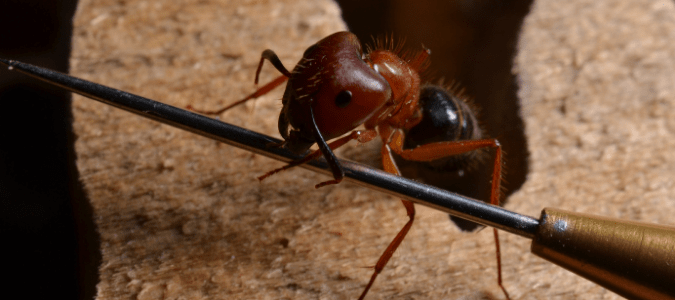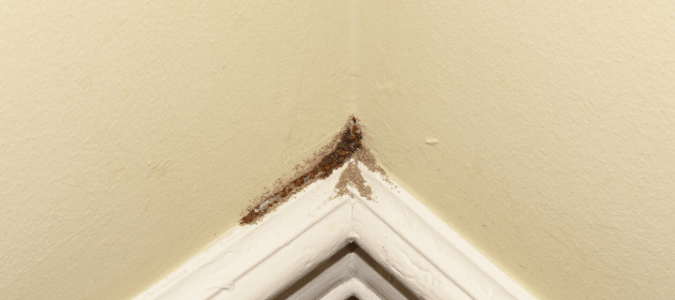If you’ve seen what look like ants with black tails and reddish-brown heads around your home, you may be dealing with a carpenter ant infestation. Carpenter ants are annoying pests in homes because they chew through wood. This causes structural damage that can be a nuisance to fix. If you have a carpenter ant infestation, it should be addressed quickly.
Signs of Carpenter Ants In Your Home
What are the common signs of a carpenter ant infestation? First, you might notice ants themselves. Their bodies are reddish-brown or black in color and up to a quarter-inch to a half-inch in length. Most people see carpenter ants in places with a ready water source, like the kitchen or bathroom. Carpenter ants swarm in spring, usually after a warm rain. Swarmers are reproductive ants with wings. You might see the winged ants or the wings they shed after swarming out of the nest to find a mate.
Carpenter ants are typically nocturnal and are often not out foraging for food during the daytime. In addition to spotting ants, you might notice another sign of carpenter ant activity called frass—what looks like bits of sawdust. You might spot frass on the floor or windowsill near baseboards or wood framing. You may even notice that the frass can be the insulation that they tunnel through. Looking closely, you may see that the wood has tiny pinholes. When carpenter ants tunnel through wood, they make these tiny holes to push the frass out so they can keep tunneling.
Still, many homeowners’ first sign that they have an infestation is by seeing a fresh pile of frass that popped up overnight. One way to check if there is an active infestation is to clean up the frass pile and monitor the area. If the frass returns, carpenter ants are present in your home, and you should call in a pest control professional.
Another sign of carpenter ants is rustling noises coming from inside the walls or ceiling. This is usually only noticeable at night when the house is quiet.
Carpenter Ants Versus Termites
It can be hard to distinguish between a carpenter ant and a termite, but there are some key differences. Carpenter ants have segmented bodies with narrow waists, while termite bodies are the same width up and down. Carpenter ants are also bigger overall than termites. They have elbowed antennae instead of the straight antennae that termites have. Also, their two sets of wings are of different lengths, while termites have two sets of wings that are the same length.
It can also be difficult to tell the difference between carpenter ant damage versus termite damage. Termites are incredibly destructive in homes because they consume the wood they chew on. Carpenter ants tunnel through the wood, but they don’t consume it. Instead, they feed on sugars and proteins, like plant juices and other insects. In a home, they will also happily feed on bread crumbs, honey, jelly and even pet food—all things they might find in a kitchen.
Since carpenter ants don’t eat the wood they tunnel through, they are less destructive than termites. Still, they can cause damage, making a house, deck or other structure weak and unsafe. Furthermore, the presence of carpenter ants is a sign of a moisture problem in a home because they typically tunnel through damp wood rather than dry wood.
Any of the above signs point toward a possible carpenter ant infestation. Since these pests can cause real damage to your home over time, it’s important to have a pest control professional inspect your home if you spot any potential signs of carpenter ant activity.
A pest control specialist can determine if a carpenter ant nest exists in or around your home and they can treat your home for ants or other pests. A specialist can also set up a custom schedule for follow-up inspections and treatments.
Where Do Carpenter Ants Live?
Where do carpenter ants live? This is a question many homeowners wonder when they learn there is a carpenter ant infestation on their property. Most of the time, the primary carpenter ant colony is located outside where they live in trees and logs. Carpenter ants typically build their nests in damp wood that they hollow out. They can also nest in dry wood, but damp wood is much easier for them to excavate. That’s why a carpenter ant infestation is often a secondary problem to a more primary issue: an undiscovered leak somewhere in the home.
Carpenter ants found inside the home often nest in places where water has collected, softening the wood where the ants build their nest. This might be wood near a kitchen or bathroom sink, bathtub, window or exterior door. Leaks in the roof or walls that let in rainwater can lead to carpenter ant infestations. So can leaky pipes.
Carpenter ants can also build nests inside rotting wooden structures. You might notice them in a wooden deck, storage building or garage. The problem with rotting wood is that it is structurally unsound.
Even without carpenter ants or other pests, damp, rotting wood is weaker than dry wood. Once ants or other pests move in, that structural integrity is further weakened. If the ants are left untreated, the original colony can expand to satellite colonies nearby.
With so many ants tunneling through wood, the damage they cause can be extensive over time. While it can take carpenter ants a long time to cause extreme structural damage, they can bring down a wooden structure over time. Wooden decks and stairs can collapse due to the combination of wet, rotting wood and carpenter ant damage.
If you have a carpenter ant issue, it’s time to contact a pest control professional who can inspect your home and determine whether you have carpenter ants or some other pest. A pro can develop a pest control treatment plan customized to your home and infestation. They know how to prevent ants and can schedule follow-up treatments.
Carpenter Ant Versus Termite Frass
Frass looks like wood shavings or sawdust, but it’s something created by insect pests. Carpenter ants and termites create frass. This is the wood-based byproduct they produce when chewing through wood. There are some important differences between carpenter ant versus termite frass. Knowing these differences helps you determine which type of pest you may deal with when you find frass in your home.
Some people call frass “droppings,” which is accurate since carpenter ant frass and termite frass contain waste products from the pests’ bodies. To the naked eye, though, frass doesn’t look like ant or termite feces. It simply looks like wood shavings or sawdust.
Most people spot frass near wooden baseboards or framing around doors and windows. You might notice a pile of tiny wood shavings on the windowsill, for example, or on the floor near the wall. If you look closely at the wood nearby, you might be able to spot very small holes or cracks in the wood with more of these tiny shavings in the opening.
Both termites and carpenter ants tunnel through wood and create tiny holes in the wood as they go. They use these holes to push the frass out. This creates more space inside, so they can keep tunneling. However, there are some key differences between the types of frass these two pests create.
Carpenter ants don’t eat the wood that they chew through. They eat other things for nourishment, including plant nectars and other insects. These ants tunnel through wood to create hidden open spaces within, where they can build a nest, lay eggs and store food. The inside of a cavern created by carpenter ants usually has smooth surfaces.
Termites, on the other hand, do consume the wood as they chew. Termites feed on the cellulose within wood—the plant fiber that gives wood its structure. The surface of the tunnels they create in wood is much more rough and ragged than in carpenter ant caverns.
The frass that both pests create differs based on the contents of the frass. Both types of frass contain wood particles, but carpenter ant frass can also be made up of tiny bits of dirt, feces and dead insects. The frass created by these ants looks like light-colored, varying sizes of wood shavings that may be loosely mixed with other, darker flecks.
Termite frass, on the other hand, is more like compacted little pellets. These pellets are a darker color and more uniform in size than the varying bits that make up carpenter ant frass. Termite frass is also a darker color than carpenter ant frass.
If you are seeing either type of frass anywhere in your home or on your property, it’s a good idea to reach out to a pest control specialist for help. Termites can create a lot of damage quickly. Carpenter ants don’t work as fast as termites, but they still cause a lot of property damage over time if they aren’t treated and eliminated.
The best way to treat carpenter ants is to eliminate their nests, but this can be very hard for the average homeowner to do on their own. This is why it’s often best to hire a professional to handle the job. A reputable pest control professional has the specialized training and tools needed to identify and eliminate pests to ensure the safety of your home.
ABC Can Treat the Carpenter Ants on Your Property
If you’re dealing with carpenter ants, contact ABC Home & Commercial Services. Our professionals will create a custom pest treatment plan for your property. We even offer preventative pest control services so that any potential pest problems will be stopped in their tracks.



